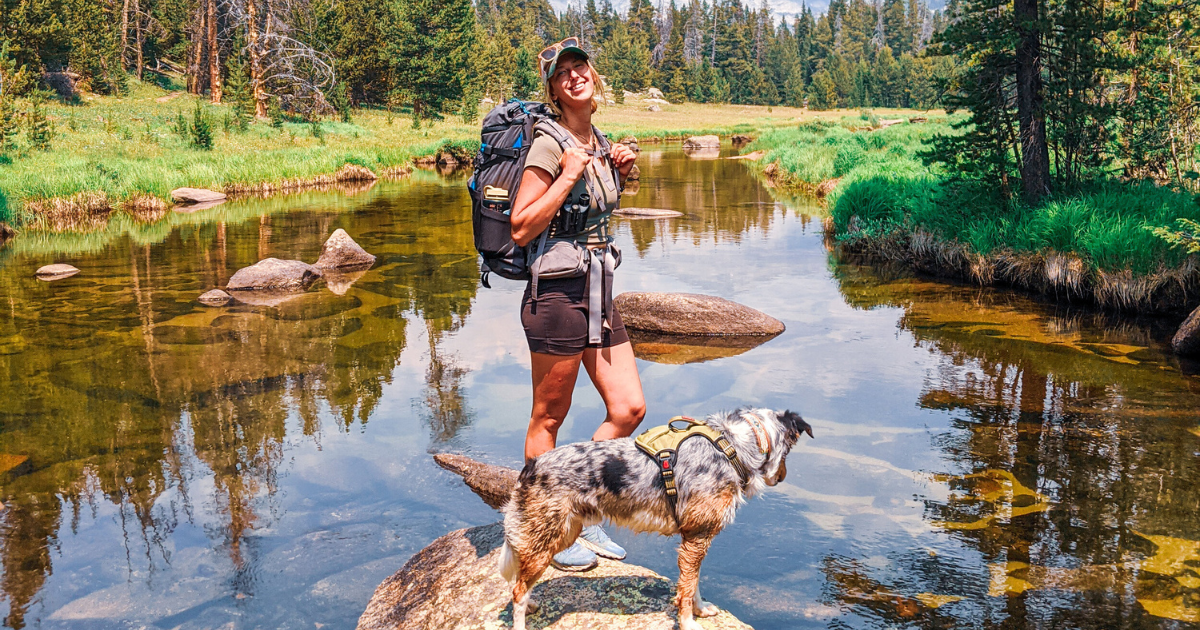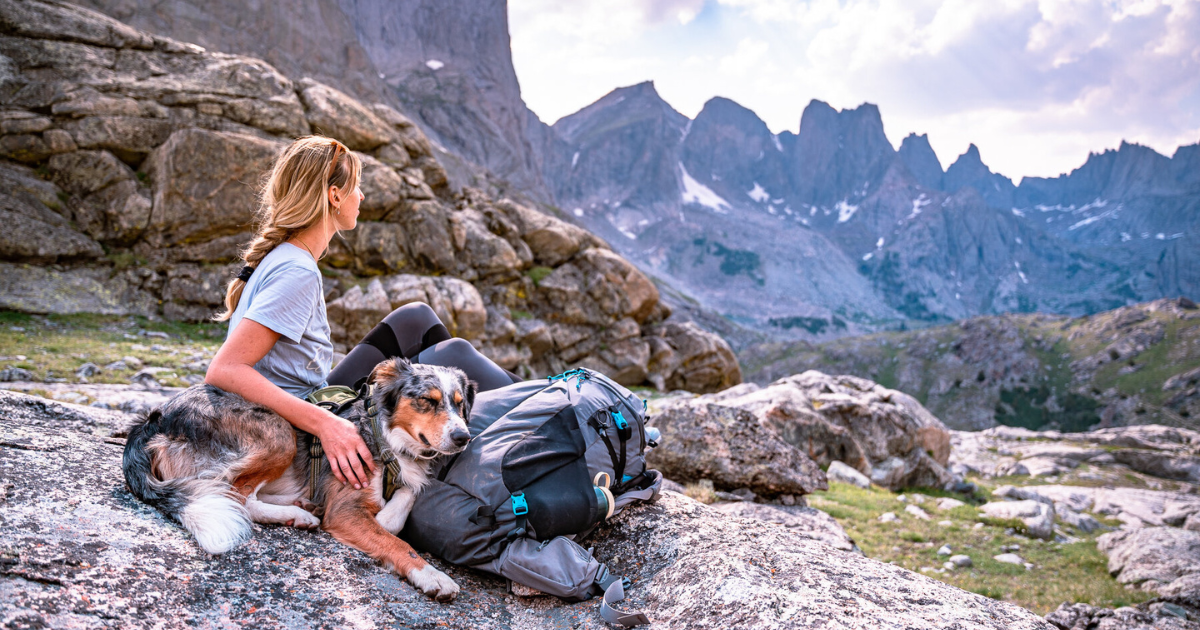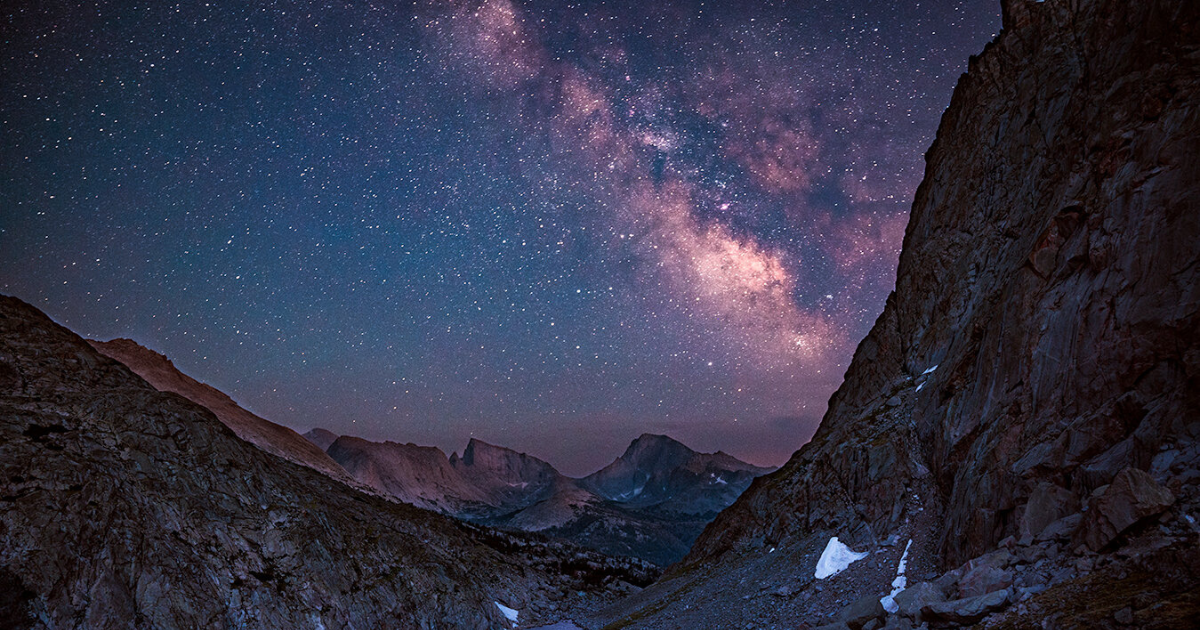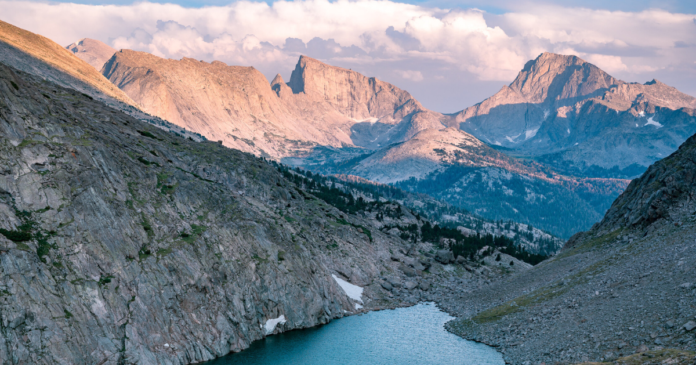How to get to the Wind River Range of Wyoming
The Wind River Range is nestled southeast of the Grand Tetons. The mountain drama, the sheer rock rising vertically out of the plains that is so dramatic in the Tetons, is also gloriously present in the Wind Rivers as well. But the Wind River Range requires more effort to get to, and thus, doesn’t have the crowds of its big brother in the National Park. Wind River Range is a mountain range in west-central Wyoming.

What to bring hiking the Wind River Range
Equipped with bear spray, parachord, and a Kevlar tear-resistant bear bag, the three of us set off from the Big Sandy Trailhead. For six miles the trail rises steadily, following along the Big Sandy River. The trail is fairly easy for this stretch, and it is beautiful and rewarding. There are many delightful spots to stop and sit on a boulder in the river and grab a snack.
Big Sandy Lake Wyoming
At six and a half miles we came across Big Sandy Lake, a large blue lake sitting in a basin below half a dozen granite domes. Here is a superb spot for many to call it a day and find a place to camp. There are plenty of campsites that have excellent views of the mountains that surround the lake. If a mellow backpacking trip with a big payoff sounds good to you, then this must be added to your tick list!
Cirque of the Towers and the Jackass Pass
However, just behind Big Sandy Lake lies a gem of unimaginable beauty, the Cirque of the Towers. At the backside of the lake, the trail immediately becomes steep and challenging and it may scare off those with knee problems. Another three and a half miles of lung burning incline, the ascent up Jackass Pass is no joking matter. Each time we thought we had ascended the last pitch, we were met with another challenge.

Near the top of the pass, the trail forks. To the left is a climber’s trail along Arrowhead Lake. To the right, the main trail continues on to the high point of Jackass Pass. For those who like a little route finding and hopping from boulder to boulder, the Arrowhead Lake route will save you some precious vertical steps. We chose the traditional route up and over the pass. While it was another few hundred feet of vertical, the view from the pass into the Cirque is well worth it. The pass provides a grand reveal of one of the mightiest concentration of granite peaks in the United States.
Wind River Range
The Wind River Range, geologically speaking, is brand spanking new. With only a few million years of age under its belt, the peaks haven’t had time to crumble and decay. They are still spritely and full of adolescent energy. Here in the Cirque, the likes of War Bonnett Peak, The Sharks Fin, and more toothy towers stand in a semi-circle above a green valley littered with massive boulders and stunted pine trees.
This spot right here, is one of the finest displays of mountain majesty I have seen anywhere in the world. Just one of these towers on its own would inspire anyone. But to assemble them in a crown above pristine meadows full of wildflowers and trickling cascades just boggles the mind. The concentration of beauty is hard to comprehend, but simple to appreciate.

Initially, Kristi and I set up camp near the top of a ridge that afforded us views into the Cirque as well as down the valley back towards Big Sandy Lake. But a swift windstorm squashed those plans. The violent gale tried to rip our tent from the ground with Kristi still inside it. They don’t call it the Wind River Range for nothing.
We retreated to a lower, more protected spot, but were still treated to a spectacular perch to stare off into the Cirque for the next two days. The only problem, we found, was that we didn’t pack enough food to live here indefinitely.

Big Sandy Trailhead
The most direct trail to the Cirque of the Towers is via the Big Sandy Trailhead. There are three main roads that can get you here. All are long and painfully slow with washboards. The quickest road approaches from Boulder, Wyoming south of Pinedale.
Bridger-Teton Wilderness
The Cirque of the Towers is in the Bridger-Teton Wilderness. Permits are not required. No drones are allowed in the wilderness area. The Bridger Teton Ranger Station can be reached at 307-739-5500.
Follow Big Sandy Trail toward Big Sandy Lake
Depart from Big Sandy Trailhead and follow Big Sandy Trail #99 for 6.5 miles towards Big Sandy Lake. The trail forks multiple times in the first couple miles to other parts of the wilderness. At Big Sandy Lake take the left fork towards Jackass Pass and Lonesome Lake. After 3 more miles the trail forks before Arrowhead Lake, either trail will take you into the Cirque. What’s labeled the “Climbers Trail” requires some boulder hopping and is a less traditional trail, but is more direct.
Camping in bear country
Despite the recent news of a woman being dragged from her tent by a bear, Kristi, Kovu, and I set off for a three day backpacking trip in the Wind River Range of Wyoming. Kristi is well versed in hiking, but backpacking is a new endeavor for her. A few months prior we went on our first backpacking trip. Unless she’s been lying to me, she enjoyed the trip and has been keen for more ever since. But Wyoming is bear country, and this was Kristi’s first time backpacking with the lingering threat of a grizzly. The recent news hadn’t helped. Kristi was a little nervous about the idea of a bear coming into our tent, or of Kovu trying to be our protector and deciding to take on a beast many times his size and power.
Camping in the Cirque of the Towers
Dispersed camping is permitted anywhere except for within ¼ mile of Lonesome Lake. Although wag bags are not required, it’s an alpine environment. Poop with care, dig 6-8 inch cathole and bury. Consider packing out your toilet paper. Due to its popularity, if this zone is not well cared for, it will likely become regulated.

Backpacking in bear country
The Wind River Range, like much of the mountains in Wyoming, is bear country. Proper food storage, such as bear canisters or bear bags are mandatory. Bear bags should be inaccessible to bears, hung at least ten feet off the ground and four feet away from a tree or rock face. All scented items, such as deodorant, toothpaste, and of course, food, should be stored in the bear bags overnight and away from camp. It’s also a good idea to prepare and eat food away from camp, as it’s easy to contaminate your camp with small food particles that can attract bears.





